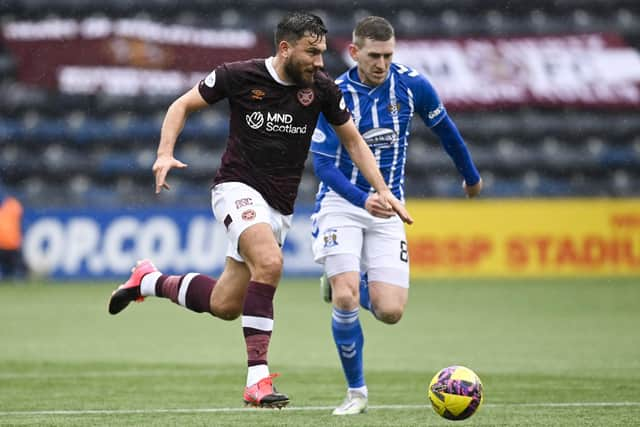How Robert Snodgrass became first name on Hearts team sheet - his duty, trust, adaptability and creative stat
All seven have or are in the process of leaving an indelible mark at Tynecastle Park. Few, however, have done so quite as quickly as Snodgrass. The experienced midfielder was without a club when Joe Savage and Robbie Neilson convinced him his future lay in Gorgie. It was one of those signings that prompted a nod of the head; a sensible addition, plenty of experience and another body at a time when the team were in the midst of an injury crisis which they are yet to fully emerge from.
Across four months and 14 appearances, the 35-year-old has become a central figure. From someone supporters gathered would be a useful squad player, he is, to many, the first name on the team sheet and a firm fans’ favourite.
Advertisement
Hide AdAdvertisement
Hide AdAdaptability
He has achieved this status by being the player fans didn't know they were getting nor the player they knew they needed. In Scotland, memories of Snodgrass, whether it was with Livingston as a precocious talent, the national team or across the majority of his more than 300 games in England's top two tiers, revolve around a forward who would provide a goal or creative threat as a No 10 or out wide. Over the last couple of years he has had to adapt his game somewhat at both West Brom and Luton Town and now even more so at Tynecastle. He is the midfield fulcrum, the team's reference point.
No such problem for Snodgrass, who values the importance of adaptability.
“I'll play anywhere,” he said. “At Luton they played me as a No 6, at West Brom they played me as a No 6. I don't know where it came from. I was always a No 10 or a winger, it just came out of the blue. West Brom was different, I never really got much of the ball. Luton was slightly different, it was half in between. [Nathan Jones] played me as a No 10 in the play-offs and he said 'that was the best game you've played'. Because I'm a No 10, that's where I've always played!
"I've never relied on pace. I've never had any pace. The lads laugh every day, 'how have you played [top level], you cannae run'. Your mind moves quicker. You do have to adapt. Those lads will get it all the way through their career as well. There will be certain times, certain circumstances, different clubs, you do need to adapt. I think that's the biggest word in football. You do need to adapt. I've probably had to do that a lot throughout my career.”


Snodgrass’ duty
Watching him patrol and control the midfield for Hearts is hugely enjoyable. The experience, the intelligence, insight and vision dripping into and out of each pass. In the recent Edinburgh derby, a 3-0 win at Tynecastle Park, opponents were wary about getting too tight with a drop of a shoulder, shimmy of the hips or a wee glance enough to create room in a midfield which so often resembles a game being played in a phone box. Where others suffer from claustrophobia, Snodgrass is able to breath and have space aplenty.
"A good footballer is somebody who can offer the perfect solution in an unpredictable situation,” Arsene Wenger once mused. That has been Snodgrass’ influence for Neilson’s side. Since finding his feet and fitness, Hearts have lost just one of the last nine games. During that time he has assisted three goals and scored his first. No Hearts player has created more chances. He is not only one of the most prolific passers in the league but one of the most accurate. When team-mates are under pressure, in trouble or unsure, he is the one they look to for help, for guidance. He wants them to continue to do so, to trust him. He sees it as a “duty”. “If anything goes wrong I'll take responsibility,” is his message.
He is a leader. It is a familiar sight, Snodgrass directing his team-mates, encouraging and cajoling. The manager on the field. During a break in the recent St Mirren game, he held forth in the middle of the pitch as the team struggled to get to grips with the home side's intensity.


Trust yourself
"First and foremost, the lads need to trust you to deal with it in there," he said. “You can keep it for us, you can make things happen, you can find the next phase, you can get through the lines. I've always tried to have that coming from the streets, give me the ball, I'll try and make something happen or give it into the danger zones for the attacking lads to go and do it. Hopefully they can trust me now. It just takes time.
Advertisement
Hide AdAdvertisement
Hide Ad"People speak about bravery and courage. I want to give them an option as much as I can to try and help. That's what football is made up of, options, angles, bravery, composure, taking the ball in tight areas, that's what the top players do at every single level and that's how they get out of tight spaces, how they create overloads, 4v2s, 4v3s. Try and get into that rhythm to trust yourselves in those pockets, in those zones. Once we get in there go and express yourself.
“It's 11 v 11, you are going to have men on you, that's the whole point. If somebody moves on me or two move on me, find the next space. That's all the little bits I feel as if we're getting better at. We are starting to control games and starting to cause teams problems in the final third but it starts from the backline.”
Comments
Want to join the conversation? Please or to comment on this article.